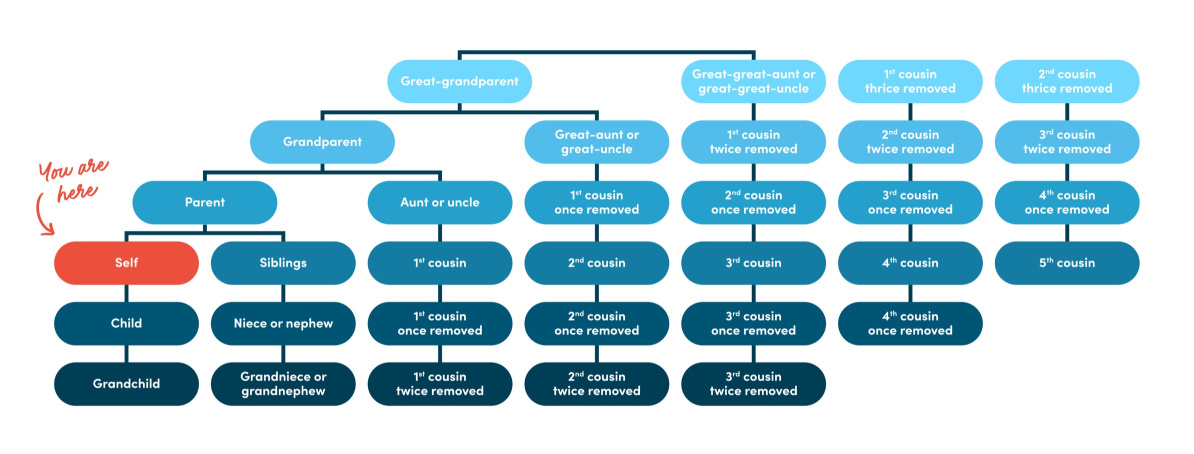Family Matters

In most Canadian provinces, the third Monday in February marks Family Day, a statutory holiday. Although family can be complicated in many ways, we can at least clarify familial terminology. From your closest relatives to the most distant, here is a guide to who’s who in the family zoo.
Immediate Family
The term immediate family loosely refers to close family members, but its meaning can differ across contexts. It generally designates family members who have regular contact, usually parents, siblings, children and spouses. But of course, everyone has a unique family experience, and their perception of who their immediate family is may vary. It could include distant relatives such as cousins or great-grandparents.
Meanwhile, in medical and legal contexts immediate family has a stricter definition. Medically, immediate family refers to those direct genetic relations that indicate one’s risk for heritable diseases or that are more likely to be able to donate biological material. Great-great-grandparents may be included, while cousins are excluded. Legally, immediate family determines eligibility for inheritance, insurance coverage and immigration, which depends on the exact legal context.
Step-family
Families can also include non-blood relatives, such as spouses. Sometimes spouses have children from previous relationships, such that the children of one family are directly related (biologically or through adoption) to only one of the parents. The prefix step- indicates this kind of familial relationship.
Similarly, when children share a biological relationship with only one parent, they are half-siblings. Of course, there are no other half-relatives besides half-siblings.
| Term | Relationship |
|---|---|
| stepfather, stepmother, step-parent | a spouse of one’s direct parent |
| stepdaughter, stepson, stepchild | a direct child of one’s spouse |
| stepbrother, stepsister, step-sibling | a direct child of one’s step-parent |
| half-brother, half-sister, half-sibling | a sibling who shares only one biological parent |
Don’t confuse step-parents with parents-in-law (read about in-laws below). While both relationships stem from marriage, they are distinct. A step-parent is married to one’s direct parent; a parent-in-law is a spouse’s parent.
Generations of Greatness
The prefix grand- signifies a familial relationship that spans one generation. Thus, grandparents are the parents of the preceding generation, and grandchildren are the children of the succeeding generation. Exceptionally, great-aunt and great-uncle are used for the aunts and uncles of the previous generation. Although the variants grandaunt and granduncle are recognized, they are not as commonly used.
| Term | Relationship |
|---|---|
| grandfather, grandmother, grandparent | a parent of one’s parent |
| grandson, granddaughter, grandchild | a child of one’s child |
| grandniece, grandnephew | a grandchild of one’s sibling |
| great-aunt, great-uncle | an aunt or uncle of one’s parent |
For each subsequent generation, another great- is prefixed:
| Term | Relationship |
|---|---|
| great-grandparent | a grandparent of one’s parent |
| great-grandchild | a grandchild of one’s child |
| great-grandniece | a great-granddaughter of one’s sibling |
| great-great-aunt | a great-aunt of one’s parent |
| great-great-grandparent | a great-grandparent of one’s parent |
| great-great-grandchild | a great-grandchild of one’s child |
| great-great-grandniece | a great-great-granddaughter of one’s sibling |
| great-great-great-aunt | a great-great-aunt of one’s parent |
One could continue this pattern indefinitely, but for the sake of readability, it is recommended to set the limit at two greats.
Cousins
Extending the branches of a family tree reveals a multitude of cousins with increasingly complex relationships as one moves away from the trunk.

- First cousins share the same grandparents. They are the children of parents’ siblings. They are the people most often referred to when we say “cousins”.
- Second cousins share the same great-grandparents. They are the grandchildren of great-aunts and ‑uncles, or phrased differently, the children of parents’ first cousins.
- Third cousins share the same great-great-grandparents. They are the great-grandchildren of great-great-aunts and ‑uncles, or the grandchildren of grandparents’ cousins.
The pattern continues as such. For each increase in the generation of the first common ancestor, so the ordinal number associated with the cousin increases.
However, some cousins have different grandparents (or great-grandparents, etc.). The grandparent of one cousin could be the great-grandparent of another. This generational gap is described with the modifier removed. Once removed indicates one generation of difference between the first common ancestor; twice removed indicates two generations of difference; thrice or three times removed (both terms are used) indicates three generations, and so on. The table below details some cousins, illustrating the pattern:
| Term | Ancestry | Relationship |
|---|---|---|
| first cousin once removed | one generation away from being a first cousin | • a parent’s first cousin • a first cousin’s child |
| first cousin twice removed | two generations away from being a first cousin | • a grandparent’s first cousin • a first cousin’s grandchild |
| second cousin once removed | one generation away from being a second cousin | • a parent’s second cousin • a second cousin’s child |
| … | … | … |
| fourth cousin three times removed | three generations away from being a fourth cousin | • a great-grandparent’s fourth cousin • a fourth cousin’s great-grandchild |
This leads to polysemy: while your grandparent may be someone’s great-grandparent, your great-grandparent could also be someone else’s grandparent—both lead to first cousins once removed. Conveniently, this results in reciprocal relationships: you are a first cousin once removed of your first cousin once removed.
That being said, most people don’t pay attention to these long, abstract titles. For the most part, cousin will always be there for you as a catch-all familial term.
Marriage
There are two ways to be related through marriage: either by marrying into another family, or by having someone marry into your family. To identify people related through marriage, we use the affix ‑in-law, and we often call these people in-laws. Because there are two ways to be in-laws, this results in polysemy:
| Term | Relationship |
|---|---|
| mother- or father-in-law | the mother or father of one’s spouse |
| daughter- or son-in-law | the wife or husband of one’s child |
| sibling-in-law | • the sibling of one’s spouse • the spouse of one’s sibling |
| aunt- or uncle-in-law | • the aunt or uncle of one’s spouse • the spouse of one’s aunt or uncle (more often simply called aunt or uncle) |
In the plural, the forms ending in ‑in-laws (e.g. mother-in-laws) are rare and usually considered incorrect. It is recommended to add the plural marker ‑s to the base rather than to the affix:
mothers-in-law
brothers-in-law
aunts- and uncles-in-law
A Family of Hyphens
With all this overlap in terminology, text can become bogged down in affixes. Suspended hyphens can lighten the work. When a term has a common base or affix, the repeated form can be omitted by using a suspended hyphen:
step- and half-siblings
brothers- and sisters-in-law
However, in closed compounds, the full forms are required:
grandmothers and grandfathers
*grandmothers and ‑fathers
Gender Neutrality
Gender-neutral familial terms are frequently used, not only for people identifying beyond the traditional Western genders, but also in everyday conversation. For example:
Children must be accompanied by a parent or guardian.
You are welcome to invite your cousins.
Most kinship terms have gender-neutral alternatives. However, that’s not quite the case for the siblings of our parents and the children of our siblings. Although many options exist, those that seem to have the most traction are nibling (the child of one’s sibling) and pibling (the sibling of one’s parent).1 However, while nibling has made headway into common usage, pibling has yet to join those ranks. (For more details on neologisms, see our article How Do New Words Enter the Dictionary.)
Family Ties
Obviously, family ties aren’t determined by labels, but by connections. With the help of this article, though, you should be able to map out a complicated family tree and manage all the cousins at a family reunion—or plan one yourself! In the spirit of Family Day, take time to cherish yours, whether blood-related or chosen.
-
“Words We’re Watching: ‘Nibling’.” Merriam-Webster, accessed December 11, 2024. ↩




